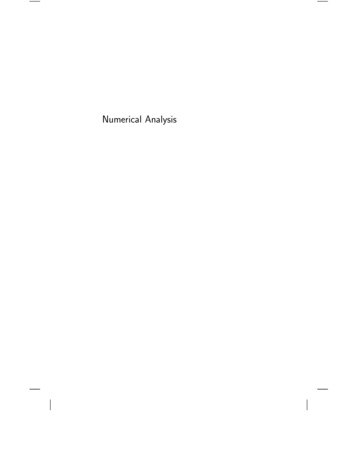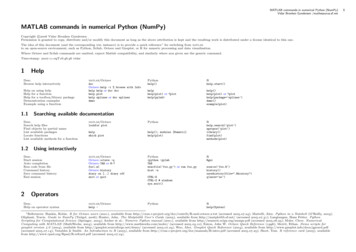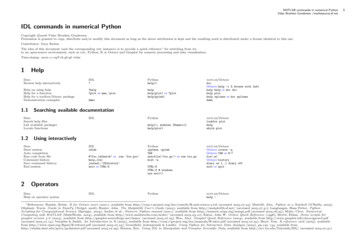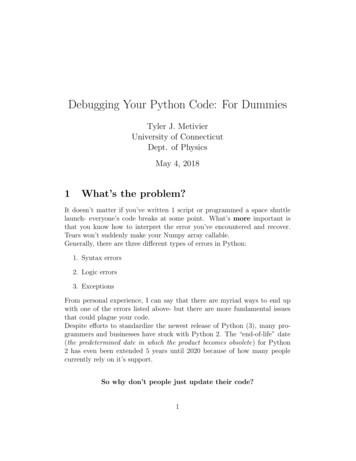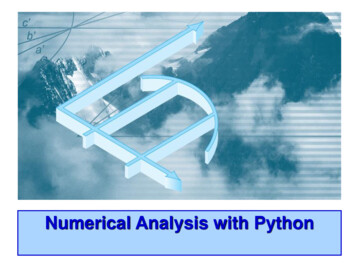
Transcription
Numerical Analysis with Python
LECTURE 01Introduction to Numerical Modelling with Python
Introduction to Numerical Analysis ‘Numerical methods are techniques by which mathematicalproblems are formulated so that they can be solved with arithmeticoperations’’. There are many kinds of numerical methods, they have one commoncharacteristic: they invariably involve large numbers of tediousarithmetic calculations. The role of numerical methods in engineering modelling andproblem solving has increased dramatically in recent years due tothe development of fast and efficient Digital Computers
Non-computer Approach to Numerical Analysis1. Analytical or Exact methods:“ provided excellent insight into the behavior of some systems.However, analytical solutions can be derived for only a limited classof problems. These include those that can be approximated with linearmodels and those that have simple geometry and low dimensionality.”
Non-computer Approach to Numerical Analysis2. Graphical Methods:“These graphical solutions usually took the form of plots ornomographs. Although graphical techniques can often be used to solvecomplex problems, the results are not very precise. Furthermore,graphical solutions (without the aid of computers) are extremelytedious and awkward to implement. ”
Non-computer Approach to Numerical Analysis3. Calculator and slides rules:“Manual calculations are slow and tedious. Furthermore, consistentresults are elusive because of simple blunders that arise whennumerous manual tasks are performed.”
Merits of Numerical Methods in Engineering1. They are capable of handling large systems of equations,nonlinearities, and complicated geometries that are oftenimpossible to solve analytically.2. They can be commercially produced as prepackaged software thatcan be use by even non-expert to solve engineering problems.3. Expert with underlining knowledge of system models can producetheir own numerical software to solve particular problem.4. Numerical methods are an efficient vehicle for learning to usecomputers.5. Numerical methods provide a vehicle for you to reinforce yourunderstanding of mathematics.
Mathematical background for NA
Mathematical Modeling & Problem solving What is a mathematical Model ?‘’is broadly defined as a formulation or equation that expresses theessential features of a physical system or process in mathematicalterms’’It can take the form;𝑫𝒆𝒑𝒆𝒏𝒅𝒆𝒏𝒕 𝒗𝒂𝒓𝒊𝒂𝒃𝒍𝒆 𝒇𝒊𝒏𝒅𝒆𝒑𝒆𝒏𝒅𝒆𝒏𝒕 ��𝒇𝒖𝒏𝒄𝒕𝒊𝒐𝒏𝒔 Dependent variable: characteristic that usually reflects the behavioror state of the system Independent variable: are usually dimensions, such as time andspace, along which the system’s behavior is being determined Forcing Functions: are external influences acting upon the system Parameters: are reflective of the system’s properties or composition
Mathematical Modeling & Problem solving Traffic mathematical Model as system of linear equations
Mathematical Modeling & Problem solving Electrical circuit mathematical Model as system of linearequations𝐼1 𝐼2 𝐼3 07𝐼1 4𝐼2 15 04𝐼2 2𝐼3 20 0
Model of a falling Object Assume a free falling object near the earth surface𝑁𝑒𝑤𝑡𝑜𝑛𝑠 𝑆𝑒𝑐𝑜𝑛𝑑 𝑙𝑎𝑤, 𝑛𝑒𝑡 𝑓𝑜𝑟𝑐𝑒, 𝑜𝑛 𝑡ℎ𝑒 𝑜𝑏𝑗𝑒𝑐𝑡 𝐹,𝐹 𝑚𝑎Or𝐹𝑎 𝑚1.1Where F, net force in NM, is the mass of the body in KgA, is acceleration in 𝑚/𝑠 2Substituting a 𝑑𝑣𝑑𝑡and net force 𝐹 𝐹𝐷 𝐹𝑉 in (1.1)𝑑𝑣 𝐹𝐷 𝐹𝑉 𝑑𝑡𝑚(1.2)
Model of a falling Object The Net force F acting on the body consist of two components1. The downward force FD due to the gravitational drag2. The upward force FV due to air resistance𝐹𝐷 𝑚𝑔 𝑤ℎ𝑒𝑟𝑒 𝑔 𝑖𝑠 𝑎𝑐𝑐𝑒𝑙𝑎𝑟𝑎𝑡𝑖𝑜𝑛 𝑑𝑢𝑒 𝑡𝑜 𝑔𝑟𝑎𝑣𝑖𝑡𝑦𝐹𝑉 𝑐𝑣𝑤ℎ𝑒𝑟𝑒 𝑐 𝑖𝑠 𝑎 𝑐𝑜𝑛𝑠𝑡𝑎𝑛𝑡 𝑐𝑎𝑙𝑙𝑒𝑑 𝒅𝒓𝒂𝒈 𝒄𝒐𝒆𝒇𝒇𝒊𝒄𝒊𝒆𝒏𝒕 𝑎𝑛𝑑 𝑣 𝑖𝑠 𝑡ℎ𝑒 𝑎𝑖𝑟 𝑣𝑒𝑙𝑜𝑐𝑖𝑡𝑦Or𝐹 𝐹𝐷 𝐹𝑉 mg 𝑐𝑣(1.3)Hence substituting (1.3) in (1.2) we have (1.4)𝑑𝑣𝑐 𝑔 𝑣𝑑𝑡𝑚(1.4)
Analytical solution to falling Object model The model that relates the acceleration of a falling object to theforces acting on it. It is a differential equation because it is written in terms of thedvdifferential rate of change ( ) of the variable that we are interesteddtin predicting. Simple algebraic manipulation can not solve the equation (1.4),hence advanced techniques in calculus is required.
Analytical solution to falling Object model For example, if the parachutist is initially at rest (v 0 at t 0),calculus can be used to solve Eq. (1.4) for 𝑽 𝒕 .𝒈𝒎 𝑽 𝒕 𝟏 𝒆𝒄Exercise: prove (1.5)𝒄𝒎 𝒕(𝟏. 𝟓)
Analytical solution to falling Object modelProblem statement 1: A parachutist of mass 68.1 kg jumps out of a stationary hot airballoon. Using analytical solution of Eq. (1.5) to compute velocityprior to opening the chute. The drag coefficient is equal to 12.5kg/s.Solution: Substituting the parameters in the equation below𝒈𝒎 𝑽 𝒕 𝟏 𝒆𝒄𝑽 𝒕 9.81(68.1)𝟏𝟐. 𝟓𝟏 𝒄𝒎 𝒕𝟏𝟐.𝟓 𝟔𝟖.𝟏 𝒕𝒆𝑽 𝒕 𝟓𝟑. 𝟒𝟒 𝟏 𝒆 𝟎.𝟏𝟖𝟑𝟓𝟓𝒕
Analytical solution to falling Object model Computing velocities at different times yields the following results𝑽 𝒕 𝟓𝟑. 𝟒𝟒 𝟏 𝒆 𝟎.𝟏𝟖𝟑𝟓𝟓𝒕Velocity 787301832652.987849632853.126777183053.22301791 53.44Analytical Method to Falling Object605040velocity m/sTime(s)3020100010203040Time (s)506070
Numerical solution to falling Object model To solve the problem modelled by Eq. (1.4) numerically, we can use𝑑𝑣finite difference method (Euler's Method ) to approximatein Eq.𝑑𝑡(1.4)𝑑𝑣 Δ𝑣 𝑣 𝑡𝑖 1 𝑣 𝑡𝑖 𝑑𝑡 Δ𝑡𝑡𝑖 1 𝑡𝑖(1.6) Now using (1.6) in Eq. 1.4 we have,𝑣 𝑡𝑖 1 𝑣 𝑡𝑖𝑐 𝑔 𝑣𝑡𝑖 1 𝑡𝑖𝑚 On rearranging the equation above𝒗 𝒕𝒊 𝟏𝒄 𝒗 𝒕𝒊 𝒈 𝒗 𝒕𝒊 (𝒕𝒊 𝟏 𝒕𝒊 )𝒎(𝟏. 𝟕)
Numerical solution to falling Object model 𝑣 𝑡𝑖 1 𝑖𝑠 𝑛𝑒𝑤 𝑣𝑒𝑙𝑜𝑐𝑖𝑡𝑦 𝑣 𝑡𝑖 𝑖𝑠 𝑜𝑙𝑑 𝑣𝑒𝑙𝑜𝑐𝑖𝑡𝑦, 𝑡𝑖 1 𝑡𝑖 𝑠𝑡𝑒𝑝 𝑠𝑖𝑧𝑒 𝑜𝑟 𝑡𝑖𝑚𝑒 𝑑𝑖𝑓𝑓𝑒𝑟𝑒𝑛𝑐𝑒Problem statement 2 A parachutist of mass 68.1 kg jumps out of a stationary hot airballoon. Use numerical solution of Eq. (1.7) to compute velocityprior to opening the chute. The drag coefficient is equal to 12.5kg/s. Use 𝑡𝑖 0 and 𝑡𝑖 1 2𝑠 .Solution: Substituting the parameters in the equation belowStep 1:𝑡𝑖 0, 𝑣 𝑡𝑖 0𝑠𝑡𝑒𝑝𝑠𝑖𝑧𝑒 𝑡𝑖 1 𝑡𝑖 2 0 2𝑠𝒗 𝒕𝒊 𝟏 𝒗 𝒕𝒊 𝒈 𝒄𝒗 𝒕𝒊𝒎𝒕𝒊 𝟏 𝒕𝒊
Numerical solution to falling Object model𝒗 𝒕𝒊 𝟏𝟏𝟐. 𝟓 𝟎 𝟗. 𝟖𝟏 𝟎 𝟐𝟔𝟖. 𝟏𝒗 𝒕𝒊 𝟏 𝟏𝟗. 𝟔𝟐 𝒎/𝒔Step 2: now at , 𝑡𝑖 2 𝑠, 𝑣 𝑡𝑖 19.62𝑚/𝑠𝟏𝟐. 𝟓 𝟏𝟗. 𝟔𝟐 𝟐𝟔𝟖. 𝟏 𝟑𝟐. 𝟎𝟒 𝒎/𝒔𝒗 𝒕𝒊 𝟏 𝟏𝟗. 𝟔𝟐 𝟗. 𝟖𝟏 𝒗 𝒕𝒊 𝟏Step 3: : now at , 𝑡𝑖 4 𝑠, 𝑣 𝑡𝑖 32.04𝑚/𝑠𝒗 𝒕𝒊 𝟏𝟏𝟐. 𝟓 𝟑𝟐. 𝟎𝟒 𝟗. 𝟖𝟏 𝟑𝟐. 𝟎𝟒 𝟐𝟔𝟖. 𝟏𝒗 𝒕𝒊 𝟏 𝟑𝟗. 𝟗𝟎 𝒎/𝒔 Repeating at subsequent intervals will yield the results below
Numerical solution to falling Object modelTime(s)Velocity 48.017916541250.01019387Numerical methods to falling 893808832253.096111022453.224146625040Velocity 0010203040Time m/s506070
Numerical Methods with Python Given the two approaches (analytical and numerical), its obviousthat the numerical approach can find solution similar to the exactsolution. Tedious computation is needed to get more accurate results, butfortunately this can easily be done using computer. The numerical solution to falling object problem can beimplemented using a software package like PYTHON andMATLAB to easily fine solution. Throughout the course PYTHON will be used for numericalanalysis
Numerical Methods with Python Python IDE and Installation: There many Integrated developmentenvironment (IDE) use to create python program. In this course Python SPYDER IDE distributed by Anaconda isrecommended For instructions on how to download and install python SPYDERon different operating systems visit the link below:1. https://www.anaconda.com/distribution/ Anaconda is one of several Python distributors. Pythondistributions provide the Python interpreter, together with a list ofPython packages and sometimes other related tools, such as editors.
Numerical Methods with Python Python packages: For scientific computing and computationalmodelling, we need additional libraries (so called packages) that arenot part of the Python standard library. The packages we generally need are: NumPy: (Numeric Python): For matrices and linear algebra Pandas: Python data science tools (Series and Dataframes) SciPy: (Scientific Python): many numerical routines matplotlib: (Plotting Library) creating plots of data Sympy: (Symbolic Python): symbolic computation Pytest: (Python Testing): a code testing framework
Numerical Methods with Python Python Spyder IDE
Numerical Methods with Python Packages Installation: all python packages can be installed via thepython installation manager found in python version 3.4 and above. In python command window or Ipython (Spyder): pip install numpy Will download and install NumPy packages In the program script:import numpy as np Will import all libraries from NumPy packages and create an objectnp of those libraries.
Numerical Methods with Python Flowchart and Pseudocodes
Numerical Methods with Python Pseudocodes for solving falling Object Using Euler’s NumericalApproach𝒗 𝒕𝒊 𝟏 𝒗 𝒕𝒊 𝒈 𝒄𝒗 𝒕𝒊𝒎𝒕𝒊 𝟏 𝒕𝒊1. Input g , c, m, stepsize2. Initialize 𝑣 𝑡𝑖 0, 𝑎𝑛𝑑𝑡𝑖 03. Compute 𝑣 𝑡𝑖 1 𝑣 𝑡𝑖 𝑔𝑐 𝑣𝑚𝑡𝑖 𝑠𝑡𝑒𝑝𝑠𝑖𝑧𝑒4. Replace 𝑣 𝑡𝑖 with new velocity computed in step 35. If stoppage criteria is not met GOTO step 3 Else GOTO 66. Return 𝑣 𝑡𝑖 17. Stop
Numerical Methods with Python Python function for solving falling Object Using Euler’s NumericalApproach𝒗 𝒕𝒊 𝟏 𝒗 𝒕𝒊 𝒈 𝒄𝒗 𝒕𝒊𝒎𝒕𝒊 𝟏 𝒕𝒊
Numerical Methods with Python Python function for solving falling Object Using Euler’s NumericalApproach𝒗 𝒕𝒊 𝟏 𝒗 𝒕𝒊 𝒈 𝒄𝒗 𝒕𝒊𝒎𝒕𝒊 𝟏 𝒕𝒊
Introduction to Numerical Analysis 'Numerical methods are techniques by which mathematical problems are formulated so that they can be solved with arithmetic operations''. There are many kinds of numerical methods, they have one common characteristic: they invariably involve large numbers of tedious arithmetic calculations.


